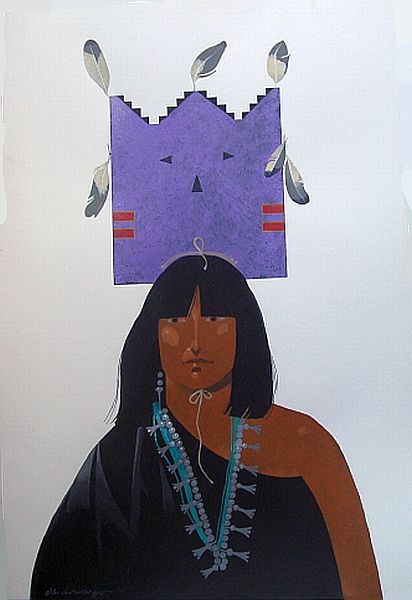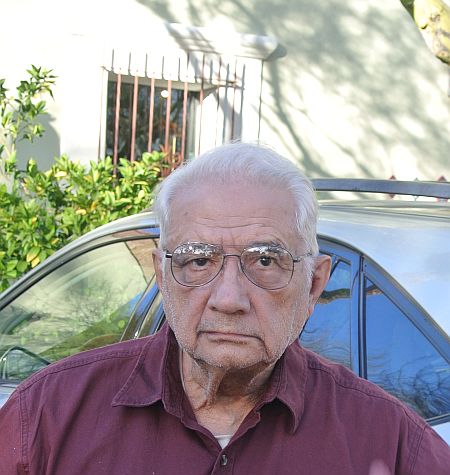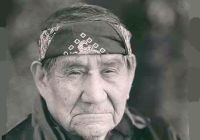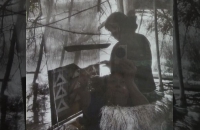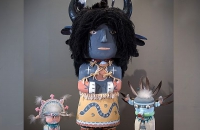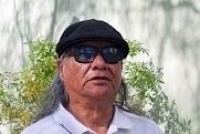PS590 "The Zuni Tablita"
Zuni Woman with Tablita --- by Arizona artist Louis de Mayo (1926-2016). The 15 x 22 original acrylic painting on paper is framed.
CALL FOR SHIPPING
The Zuni tablitas are worn by a female during a dance following the Katsina dance season. Generally, dance tablitas are made by male members of a family for use by a female family member.
Louis de Mayo’s artwork continues to inspire and capture the essence of the Native American spirit, and at the age of 90, De Mayo continued to work and create these spiritual pieces.
About the artist
Louis de Mayo
Louis De Mayo (American 1926 – 2016) is a stylized painter of contemporary Indian figures, born in Philadelphia, Pennsylvania, in 1926 and living in Phoenix, Arizona, since 1973. When a gallery owner suggested that De Mayo tell people he is Indian to facilitate sales, De Mayo asked whether "if I wanted to paint a horse, would I have to say I was part horse?" His friend, Carl Gorman who was Navajo told him, "Louis, if people ask what tribe you're from, tell them you're Awoppaho."
Louis de Mayo has lived in the Southwestern United States for many years absorbing the rich spiritual heritage of the Native American cultures that inhabit the deserts, mesas and mountains. Arizona was the catalyst de Mayo used to express himself and the freedom he has always associated with art. He was able to capture the splendor and grandeur of Arizona where he was exposed to a magical beauty and wealth of imagery. From this emerged his distinctive style and vision of the world.
EARLY YEARS:
A first generation Italian-American, “Louie” De Mayo was raised in the neighborhood that produced Mario Lanza and Frankie Avalon. "If you spit," he claims, "you would hit a singer." After serving in the Marines during World War II, he studied at the Pennsylvania Academy of Fine Arts/Hussian School of Art under the G.I. Bill; and Fleischer Art Memorial* then was employed in a series of commercial art jobs. He relocated to Phoenix as Art Director for Arizona Highways. Once De Mayo retired from the magazine he focused all his time and energy into his personal artwork, with an emphasis on Native American pieces. De Mayo says he chose Native Americans for his work because of their “dramatic quality” and “manner of dress.” His artwork continues to inspire and capture the essence of the Native American spirit, and at the age of 90, De Mayo continues to work and create these spiritual pieces.
"I really have only one regret about leaving Philadelphia, and that is that I didn't leave it sooner. I choose Indians to paint because of their dramatic quality and their manner of dress," he states. "I had a strong emotional attraction to the Yaqui and their black garb. Maybe it's because I grew up seeing women in black. My people are all dark skinned. I don't want to make too much of a racial issue in my work, but it certainly could stem from such roots. I look at life as if it were a big slow-moving steamroller. It gives you a helluva lot of time to get out of the way if you fall down, but if you just want to lie there, it is going to roll right over you."
A trailblazer in the realm of contemporary southwest art, De Mayo has been instrumental in pushing the envelope and abolishing the stereotypes of what the viewing public considers Southwestern. Working in acrylic he utilizes dramatic color, the abstract, numbers and a bit of whimsy to enhance his images and message together with a bold, daring and controlled simplicity that fill his canvases. De Mayo is best known for his interpretation of the Native American spirit, however, in recent years, he has found a renewed passion in contemporary and realistic style.
PARTIAL LIST OF COLLECTIONS:
- The Smithsonian Museum
- Museum Biedermann
- Longview Museum
- Scottsdale Museum
- major private collections
PUBLICATIONS:
- De Mayo was written up and featured on the cover of Southwest Art, December, 1980.
* Samuel S. Fleisher Art Memorial, also known asChurch of the EvangelistsandSt. Martin's College for Indigent Boys, is a set of four buildings with a history that unites idealism or religious beliefs, service to the poor, and art. Formerly anEpiscopalchurch in the working-classBella Vistaneighborhood ofSouth Philadelphia, it is best known as the home of theGraphic Sketch Clubfounded by Samuel S. Fleisher, which offers free art lessons to children and adults.
The four buildings include acampanilebuilt in 1857, a basilica built 1884-1886, St. Martin's College built in 1906, and two row houses built in the 1850s. Since Fleisher's death in 1944, his trust, which owns the buildings, has been administered by thePhiladelphia Museum of Art. The Art Memorial was listed on theNational Register of Historic Placesin 1982 and is located at 711-721 Catharine St. inPhiladelphia, Pennsylvania.

